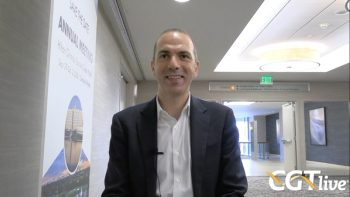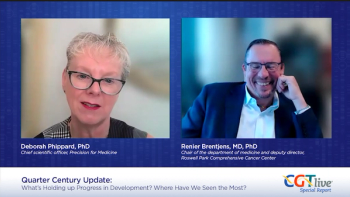
Standardized Guidelines for Preclinical Testing and Cell Characterization are Critical to Cell Therapy Development
Atul Malhotra, MD, PhD, the head of the early neurodevelopment clinic at Monash Children's Hospital, discussed the importance of preclinical guidelines in the context of neonatal cell therapy.
Atul Malhotra, MD, PhD, the head of the early neurodevelopment clinic at Monash Children's Hospital,
During the course of the discussion Malhotra spoke about the difference between cell therapies and stem cells and about the potential of cell therapy in neonatology specifically. Afterwards, he elaborated on the importance of establishing standardized guidelines for preclinical work and characterization of cells for cell therapy.
CGTLive: Can you give some background info about what Neonatal Cell Therapy is for those who don't know?
Atul Malhotra, MD, PhD: A lot of people think about cell therapies as similar to stem cells, but they're not the same thing. I’d just like to elaborate on those 2 things to start off with. Stem cells are biological cells, which are obviously derived from human tissue, that have the potential to regenerate—that means they can replicate and divide on their own and also have the potential to differentiate into different organ tissues or body types. Cell therapies, on the other hand, are biological cells. Some of them can be stem cells, but they are biological cells, which have the potential to either protect, repair, or regenerate, in some cases. Not all cell therapies are stem cells, but all stem cells are cell therapies, if that makes sense.
You wrote an article on the topic of Neonatal Cell Therapy research for us in 2022. Have there been any updates in the field since then? What is the current state of this research now?
It's important to think about cell therapies in the context of neonates. Neonatology is the care of sick, and in many cases preterm, babies. In most cases, these babies who are preterm or who are very sick and at birth, have good outcomes, but in some cases, they will continue to have morbidities, which can be short-term, or long lasting. For example, if we talk about premature babies, most premature babies do well. But the ones who are really small or born really early (sometimes we call them extremely preterm infants, for example, born after less than 28 weeks of gestation) can have significant problems down the line related to their lungs, to their brain, to their heart, and so on. With advances in neonatal care, the survival of these very fragile and very vulnerable infants is increased. But unfortunately, with survival comes their risk of long-term morbidities. Neonatology as a profession has been trying to improve the care of these [preterm] infants so they have less complications down the line. We are doing better in some aspects, but still continue to have a significant burden of disease when it comes to lung and brain complications. Cell therapy is an opportunity for us to improve those outcomes further. [We], and a number of groups around the world, have been trying to discover and then translate these cell therapies into human babies. When I say discover: cell therapy options are available in nature, like I said in human tissues and so on. For us to be able to use them as therapies for babies, they need to go through very rigorous testing, both in preclinical models in the lab, and then obviously trying to translate them into in-human conditions is vital. Since I wrote that article, probably a couple of years ago, significant advances are happening in the space of cell therapies. I think I can break it down into 2 things. There is more and more work happening on the preclinical front, in animal models of neonatal disease, in lab models of neonatal disease and conditions, as well as in the translation of those therapies into the clinic. I'll elaborate about them as we go along, but I definitely think the field of neonatal cell therapies is an exciting field, which is growing: Every time we look into that there are more and more studies and more and more researchers who are interested in this field.
Are there any interesting areas of future research for neonatal cell therapy research, or challenges that still need to be addressed?
It's very important to think about how we move the field forward. I'll start off with preclinical models and cell therapies. Preclinical models are really important to mimic or replicate neonatal conditions and diseases, but unfortunately none of the preclinical models will replicate that disease absolutely perfectly. Every model has its pros and cons. Having said that, without preclinical models, it's very difficult to actually bring these therapies into the clinic. One of the things which we have been working on is to improve the standardization and reporting of preclinical models. We have a number of guidelines available worldwide, to make sure that the preclinical work is done according to scientific rigor. For example, we have the ARRIVE guidelines for reporting scientific literature, especially in preclinical models. Then we have reporting guidelines for making sure that the protocols used in those preclinical models are reproducible and are to stand the test of time when it comes to other labs trying to replicate them. This is really important because if we have standardized models for those diseases, then we know that how one cell therapy or gene therapy might work in that model can be replicated around the world in terms of proving that this is definitely a condition or therapy worth pursuing.
Now, when it comes to translating this preclinical work into the clinic, a couple of things are really important. Cell therapies can come from a number of sources. They can come from various body organs or issues. For example, for my team in my lab, most of our work in cell therapies or stem cells is from gestational tissue—that is tissue from the placenta, from the umbilical cord, from the umbilical tissue itself, and so on. Every cell therapy has got strict guidelines of characterizing those cells. An example I can give you is mesenchymal stromal cells. The International Society of Cell Therapy has strict guidelines of how we should be characterizing and reporting those cells. That way we can identify that the cells which you obtained in one study are similar to cells obtained from another study. We talk about it in scientific literature very often that we need to know our cell therapy very well because if we do not have good characterization of those cells then we could have rogue clinics running cell therapeutic options which may not actually be well characterized. Then we don't know actually what is the exact cell type being administered to a patient, for example. I think that's one of the challenges: characterizing them, reporting them well, and so on.
The next challenge comes when we translate these therapies into the human. The first studies are always phase 1 studies or safety and feasibility studies. Those are trying to figure out in the initial dozen or couple of dozen patients which are given those cell therapies: Are they safe? But as you can understand, when you test a therapy in 20, 30, or 40 patients, you definitely cannot prove that they are completely safe. While maintaining those early phase studies, and then going into phase 2 and 3 trials, which are called randomized control trials, safety still remains paramount because obviously these are biological cells, which have the potential to have reactions, which have the potential to have long-term implications, as well. Important ethical guidelines and strict monitoring schedules need to be followed to make sure that these therapies are well-studied and their safety risks and profiles are well-documented.
This transcript has been edited for clarity.
REFERENCE
1. Lions Foundation provides support to neonatal cell therapy research. News release. Monash Unviersity. August 25, 2022. https://www.monash.edu/medicine/news/latest/2022-articles/lions-foundation-provides-support-to-neonatal-cell-therapy-research
Newsletter
Stay at the forefront of cutting-edge science with CGT—your direct line to expert insights, breakthrough data, and real-time coverage of the latest advancements in cell and gene therapy.











































